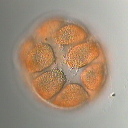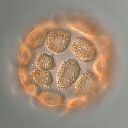Cleaving Blastomeres in the Brittle Star Ophiopholis

Ophiopholis spawns quite a lot of small orange eggs (at least it's a lot considering how small the body is). The embryos aren't nearly as easy to see into as starfish or urchin eggs, but they do some interesting things. The pictures on this page show the odd behavior of early blastomeres. The embryos develop into a feeding pluteus larva that is rather different in structure than the echinoid pluteus.

|

|

|
Newly-spawned Ophiopholis eggs look normal enough (first panel), but every time I look at them just after fertilization I feel sure that something has gone very wrong (second panel). The egg surface transiently seems to vacuolate as the vitelline envelope rises, but this is evidently just because the cortical reaction spews forth an incredible amount of hyaline layer material (third panel).

|

|

|
Throughout the first several cleavage divisions the daughter cells separate from each other completely and then actually withdraw, leaving a huge empty space between cells that contact each other only through surface projections (filopodia or, more typically, ruffly pseudopodia; second and third panels show high magnification views). Indeed, during interphase the blastomeres flatten out against the hyaline layer, express lateral protrusions, and may even crawl along the hyaline layer, although I haven't filmed cells actually moving large distances.

|

|

|
As the number of cells increases they crowd along the inner surface of the hyaline layer, such that when flattened out in interphase they run into each other. Nevertheless they round up when they divide, and again the only thing each cell contacts is the hyaline layer. Eventually they crowd so closely that they constitute an epithelial layer at all times, but not until the embryo has 64 or more cells. This unusual behavior of Ophiopholis blastomeres is highly reproducible. Every batch (out of 2 or 3 dozen batches) that I have cultured exhibits this phenomenon, and these embryos can be raised through metamorphosis, so it is definitely something normal, if unusual.

|

|

|

|
Ophiopholis live in immediately subtidal cobble beds... at least that's how to describe the one place I've been shown where they live. Ripe adults range from the size of a large spider to animals with 10 cm arms and a central disc the size of a nickel. Individuals are remarkably diverse in color pattern, ranging from blacks and browns to bright oranges and deep reds, usually with intricate designs on the central disc. They live pretty well in the lab, and eat almost anything small enough. They can often be induced to spawn by allowing them to warm up a shallow dish of seawater exposed to the sun, then putting them in finger bowls with cold seawater and relentlessly flipping them over onto their backs every time they right themselves. Sometime after you've given up on them (this seems to be essential), they will spawn. Actually someone suggested that maybe, following the pestering treatment, they just spawn when it gets dark. Maybe so.